Extensions of High Grade Mineralization Confirmed
Through Further Drilling and Geological Mapping
Results include:
1.45m @ 26.02 g/t Au from 418.25 meters
3.55m @ 12.09 g/t Au from 218.80 meters
5.80m @ 5.93 g/t Au from 63.00 meters
12.55m @ 2.73 g/t Au from 70.30 meters
3.90m @ 9.55 g/t Au from 75.65 meters
2.30m @ 20.70 g/t Au from 17.15 meters
2.40m @ 11.88 g/t Au from 30.40 meters
2.40m @ 23.47 g/t Au from 6.00 meters
North Vancouver, B.C., September 15, 2017. Lion One Metals Limited (TSX-V: LIO) (ASX: LLO) (OTCQX: LOMLF) (FSX: LY1) (the “Company”) is pleased to announce further drill results from the current diamond drilling program at its 100% owned and fully permitted high grade underground Tuvatu Gold Project located near Nadi on the island of Viti Levu in the Republic of Fiji. This phase of drilling targeted both the new zone of shallow mineralization reported on in the previous news release dated 22nd August 2017 (Drilling Identifies New Zone of High-Grade Mineralization at Tuvatu Gold Project in Fiji), as well as infill and follow up drilling of the existing resource area from both the surface and underground.
Diamond drilling
Results have been received from a number of additional diamond drill holes completed at Tuvatu gold project in Fiji. The focus of the drilling of this program of work was threefold; firstly to extend the new zone of mineralization reported in the recent news release (22nd August 2017), secondly to infill inferred zones of mineralization targeted for early development, and thirdly to undertake a first pass review of the target horizons striking south of the known mineralization. (Figure 1)
Surface diamond drill holes TUDDH 452 – 462 are further holes targeting the new zone of mineralization reported on in the last news release dated 22nd August 2017. (Figure 2, 3)
This new mineralized zone is adjacent, but separate, to mineralization previously outlined in the Tuvatu resource, and to the north of any previously defined planned ore blocks for mining, as can be seen in Figure 2. The grades intersected are significantly higher than other drill results in this immediate area and are located in the near-surface providing the possibility for early development. The current drill program is focused to the north of the east-west striking Core Shed Fault, a structure which bisects the northern end of the Tuvatu resource. Previous drilling to the north of the Core Shed Fault has identified limited and generally lower grade mineralization. The recent drilling has helped tie together these previous results and extend the known mineralization further north, and with higher-grade results than previous work had indicated. Although drilling on this target has focused on those areas north of the Core Shed Fault, this zone of mineralization is open to the northwest, southeast and at depth. Drilling has continued in an effort to determine the extent of mineralization in both directions along strike, and down-dip. All intersections to date are shallow, and all indications are that the mineralization will continue down dip and along strike.
Figure 1: Tuvatu Gold Project – 2016/7 Diamond Drilling
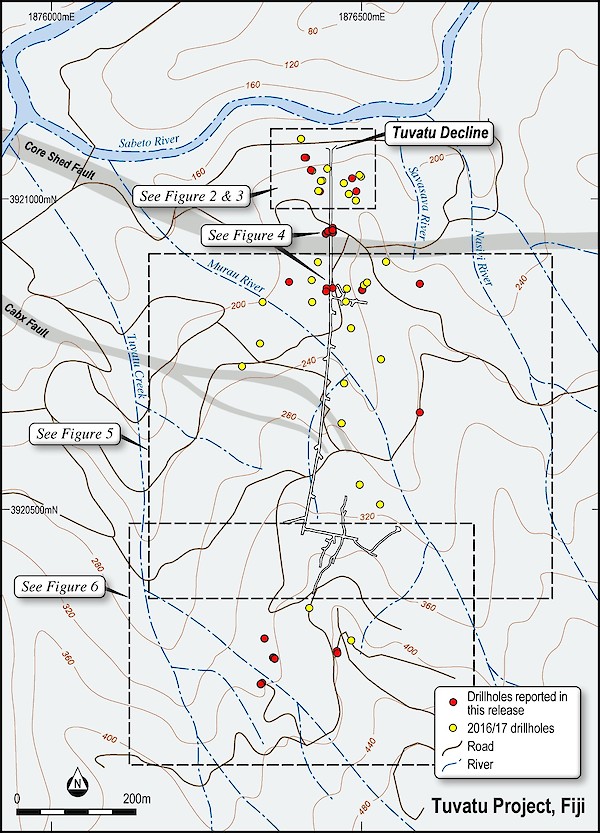
The new drilling is characterized by fine quartz veins, pyrite rich, vuggy, bleached monzonite, with zones of intense, very coarse grained biotite and -potassium feldspar alteration. The zone is characterized by intense fractures, breccia and minor faults.
Underground collared diamond drill holes TUG 114 – 129 (Figure 4), in addition to surface diamond drill holes TUDDH 429 – 431, TUDDH 434 – 441, and 443 – 447, (Figure 5) are infill holes targeting inferred areas of the existing resource at Tuvatu. Additionally, surface diamond drill holes TUDDH 432 – 433, and TUDDH 443 – 447 (Figure 6) were completed further to the south of the existing resource as a first pass examination of the extent of the mineralized structures in that area.
Results from a number of diamond drill holes which have recently been received (see Table 1), are reported in this release. The detailed logistics of each hole are included in Table 2. The drill program is continuing with results from a number of additional holes still outstanding. The location of these drill holes is outlined in Figures 1-6.
Table 1: Diamond Drill Results reported on in this News Release
|
Drill Hole |
From (m) |
To (m) |
Interval (m) |
True Width (m) |
Au (g/t) |
Lode |
| Surface drilling | ||||||
| TUDDH 429 | 303.25 | 306.30 | 3.05 | 2.12 | 6.49 | URW3 |
| 418.25 | 419.70 | 1.45 | 1.01 | 26.02 | URW1 | |
| TUDDH 430 | 199.22 | 200.30 | 1.08 | 0.94 | 8.84 | UR1 |
| TUDDH 431 | 218.80 | 222.35 | 3.55 | 2.85 | 12.09 | URW3 |
| TUDDH 434 | 191.8 | 195.95 | 4.15 | 3.82 | 2.19 | GRF2 |
| TUDDH 436 | 140.55 | 142.1 | 1.55 | 1.31 | 9.64 | UR2 |
| TUDDH 438 | 35.8 | 36.33 | 0.53 | 0.41 | 11.15 | URW2 |
| TUDDH 443 | 52.26 | 53.33 | 1.07 | 0.80 | 3.74 | UR4 |
| TUDDH 452 | 26.96 | 31.73 | 4.77 | 3.65 | 2.14 | T1 |
| incl | 31.38 | 31.73 | 0.35 | 0.27 | 15.40 | T1 |
| 39.23 | 44.10 | 4.87 | 3.73 | 1.13 | T2 | |
| TUDDH 453 | 63.00 | 68.80 | 5.80 | 1.98 | 5.93 | H |
| 63.25 | 65.25 | 2.00 | 0.68 | 13.40 | H | |
| 70.30 | 82.85 | 12.55 | 4.29 | 2.73 | H | |
| incl | 80.40 | 82.85 | 2.45 | 0.84 | 6.02 | H |
| 88.05 | 90.50 | 2.45 | 0.84 | 5.27 | H | |
| TUDDH 454 | 62.10 | 67.90 | 5.80 | 5.02 | 1.39 | West |
| 75.67 | 76.38 | 0.71 | 0.61 | 5.73 | T2 | |
| TUDDH 455 | 38.80 | 39.50 | 0.70 | 0.24 | 6.17 | T2 |
| TUDDH 459 | 75.65 | 79.55 | 3.90 | 2.99 | 9.55 | H? |
| incl | 76.70 | 78.65 | 1.95 | 1.49 | 14.97 | H |
| TUDDH 462 | 67.50 | 71.10 | 3.60 | 2.55 | 1.95 | T1 |
| 87.60 | 93.33 | 5.73 | 4.05 | 3.21 | T1 | |
| incl | 92.50 | 93.33 | 0.83 | 0.59 | 10.71 | T2 |
| 95.60 | 97.00 | 1.40 | 0.99 | 3.42 | T2 | |
| Underground drilling | ||||||
| TUG 115 | 29.70 | 32.10 | 2.40 | 2.10 | 2.33 | GRF2 |
| TUG 123 | 102.37 | 103.14 | 0.77 | 0.71 | 16.26 | URW2? |
| TUG 124 | 1.38 | 4.27 | 2.89 | 2.80 | 6.68 | SKL |
| 11.48 | 12.25 | 0.77 | 0.72 | 6.72 | GR1? | |
| 14.48 | 14.75 | 0.27 | 0.25 | 23.62 | GRF2 | |
| TUG 125 | 35.33 | 37.78 | 2.45 | 2.44 | 2.39 | SKL1 |
| 39.30 | 42.05 | 2.75 | 2.74 | 2.89 | SKL1 | |
| incl | 41.74 | 42.05 | 0.31 | 0.31 | 14.83 | SKL6 |
| 48.24 | 48.95 | 0.71 | 0.70 | 6.87 | SKL2 | |
| TUG 126 | 17.15 | 19.45 | 2.30 | 1.51 | 20.70 | SKL6 |
| 30.40 | 32.80 | 2.40 | 1.35 | 11.88 | SKL3 | |
| 45.95 | 47.20 | 1.25 | 0.49 | 3.41 | SKL3 | |
| TUG 127 | 6.00 | 8.40 | 2.40 | 1.70 | 23.47 | GRF h/w |
| incl | 6.00 | 7.40 | 1.40 | 1.00 | 39.71 | GRF h/w |
| 28.38 | 28.63 | 0.25 | 0.10 | 20.48 | SKL7 | |
| TUG 128 | 17.80 | 18.50 | 0.70 | 0.70 | 6.69 | UR2 f/w |
| 34.90 | 36.75 | 1.85 | 1.84 | 5.36 | UR2 | |
| TUG 129 | 10.94 | 12.27 | 1.33 | 0.40 | 8.11 | GRF |
| 37.25 | 37.82 | 0.57 | 0.53 | 15.66 | UR2 |
Notes: Intersections reported here are often composite samples.
Results reported here only include those which returned single intervals or composited intervals of > 4gram meters.
Those intervals highlighted have returned results >20 gram.meters of drill width
TUDDH prefix denotes diamond drill holes drilled from the surface, whilst TUG prefix denotes those holes drilled from underground.
Table 2: Drill Hole Logistics from the Current Reported Holes
| Hole Number | Northing | Easting | Depth | RL | Azimuth | Dip |
| Surface Drilling | ||||||
| TUDDH 429 | 3920656.12 | 1876595.79 | 437.80 | 283.0 | 275 | -66.0 |
| TUDDH 430 | 3920656.08 | 1876596.45 | 350.80 | 283.0 | 282 | -47.8 |
| TUDDH 431 | 3920656.08 | 1876597.65 | 371.8 | 283.0 | 255 | -56.5 |
| TUDDH 432 | 3920262.96 | 1876455.17 | 148.50 | 400.7 | 237 | -62.0 |
| TUDDH 433 | 3920262.55 | 1876455.51 | 121.80 | 400.7 | 216 | -69.6 |
| TUDDH 434 | 3920857.29 | 1876591.04 | 209.60 | 254.1 | 253 | -42.5 |
| TUDDH 435 | 3920857.37 | 1876590.99 | 200.70 | 254.1 | 270 | -51.3 |
| TUDDH 436 | 3920858.83 | 1876592.16 | 200.70 | 254.1 | 294 | -52.3 |
| TUDDH 437 | 3920884.15 | 1876382.26 | 173.80 | 215.9 | 274 | -50.2 |
| TUDDH 438 | 3920882.00 | 1876382.69 | 185.80 | 215.9 | 254 | -60.0 |
| TUDDH 439 | 3920998.96 | 1876490.06 | 212.80 | 200.0 | 090 | -61.8 |
| TUDDH 440 | 3921037.32 | 1876495.78 | 137.80 | 211.5 | 074 | -60.0 |
| TUDDH 441 | 3921026.04 | 1876471.63 | 47.80 | 163.7 | 090 | -90.0 |
| TUDDH 442* | 3921025.77 | 1876470.70 | 71.70 | 211.5 | 250 | -55.0 |
| TUDDH 443 | 3920219.819 | 1876335.001 | 170.80 | 352.9 | 077 | -57.1 |
| TUDDH 444 | 3920219.81 | 1876335.569 | 176.80 | 352.9 | 103 | -57.1 |
| TUDDH 445A | 3920258.784 | 1876361.283 | 131.70 | 352.9 | 084 | -49.3 |
| TUDDH 446 | 3920257.839 | 1876365.118 | 71.70 | 352.9 | 270 | -69.8 |
| TUDDH 447 | 3920122.337 | 1876412.098 | 173.80 | 351.0 | 086 | -49.8 |
| TUDDH 448* | 3921028.389 | 1876434.836 | 92.80 | 207.7 | 111 | -89.0 |
| TUDDH 449* | 3921028.265 | 1876433.658 | 62.70 | 207.6 | 251 | -59.6 |
| TUDDH 450* | 3921050.009 | 1876444.491 | 77.60 | 192.2 | 259 | -49.0 |
| TUDDH 451 | 3921046.647 | 1876420.049 | 71.80 | 192.6 | 207 | -88.8 |
| TUDDH 452 | 3921046.647 | 1876418.825 | 92.50 | 192.6 | 253 | -60.3 |
| TUDDH 453 | 3921066.633 | 1876409.061 | 110.70 | 179.3 | 118 | -88.7 |
| TUDDH 454 | 3921066.752 | 1876407.371 | 92.70 | 179.4 | 259 | -50.4 |
| TUDDH 455 | 3921013.26 | 1876431.926 | 101.10 | 213.0 | 158 | -89.0 |
| TUDDH 456 | 3921013.277 | 1876430.75 |
155.80 |
213.1 |
256 |
-59.5 |
| TUDDH 457 | 3921097.38 | 1876401.17 | 122.70 | 168.0 | 199 | -89.0 |
| TUDDH 458* | 3921033.39 | 1876484.53 | 125.70 | 207.3 | 235 | -58.9 |
| TUDDH 459 | 3921037.96 | 1876495.40 | 161.70 | 208.1 | 235 | -60.5 |
| TUDDH 460 | 3921037.85 | 1876495.83 | 176.70 | 208.1 | 248 | -68.0 |
| TUDDH 461* | 3921011.90 | 1876480.68 | 98.60 | 219.5 | 248 | -65.0 |
| TUDDH 462 | 3921012.77 | 1876490.64 | 110.60 | 219.5 | 248 | -65.0 |
| Underground Drilling | ||||||
| TUG 114 | 3920950.63 | 1876451.52 | 124.30 | 166.3 | 052 | +1.2 |
| TUG 115 | 3920951.23 | 1876451.53 | 32.10 | 165.3 | 039 | -39.0 |
| TUG 116 | 3920948.38 | 1876451.75 | 50.30 | 166.1 | 076 | -01.9 |
| TUG 117 | 3920946.91 | 1876445.33 | 167.10 | 165.0 | 284 | -21.0 |
| TUG 118 | 3920947.84 | 1876452.31 | 88.50 | 164.7 | 080 | -30.8 |
| TUG 119A | 3920946.69 | 1876445.06 | 165.51 | 164.2 | 265 | -33.2 |
| TUG 120 | 3920943.61 | 1876451.57 | 75.93 | 164.9 | 109 | -35.0 |
| TUG 121 | 3920948.30 | 1876452.15 | 100.89 | 164.6 | 074 | -33.8 |
| TUG 122 | 3920946.29 | 1876444.80 | 184.20 | 164.2 | 284 | -36.0 |
| TUG 123 | 3920857.58 | 1876443.77 | 140.28 | 153.9 | 276 | -30.0 |
| TUG 124 | 3920857.61 | 1876443.76 | 184.20 | 155.7 | 276 | -40.0 |
| TUG 125 | 3920852.61 | 1876441.52 | 170.86 | 153.2 | 220 | -40.0 |
| TUG 126 | 3920858.02 | 1876451.60 | 59.16 | 155.4 | 090 | +30.0 |
| TUG 127 | 3920857.89 | 1876451.64 | 57.23 | 153.0 | 090 | -35.0 |
| TUG 128 | 3920857.93 | 1876451.63 | 40.64 | 154.6 | 080 | +5.0 |
| TUG 129 | 3920854.74 | 1876451.60 | 80.42 | 152.9 | 137 | -65.0 |
Notes: * Denotes diamond drill holes previously reported in News Releases dated 22nd August 2017
For surface diamond drill holes, 10 to 20 meters of the poorly consolidated surface material was drilled using PQ3 (83.0mm core diameter) diamond core with remainder of the hole drilled with HQ3 (61.1mm core diameter) diamond core. For underground diamond drill holes, the entire hole was drilled in NQ3 core (47.6mm)
Downhole surveys are carried out using a Ranger Explorer Mark 2 electronic multi-shot camera.
Downhole surveys are taken at least once every 30 m.
Geological Mapping
Geological mapping along the HT Mineralised Structure along strike to both the north-west and south-east of this current new zone of drilling has highlighted the potential significant extent of the target zone. The prospective horizon has been mapped for over 1 km to the north-west, and in excess of 2 km south-east of the Core Shed Fault. The figure (Figure 2) below demonstrates the area which has been drilled to date, and the extensions to the area which have now been mapped, and highlights the very significant exploration upside this new zone has bought to the already high grade Tuvatu project area.
Geological mapping and trenching will continue along strike in both directions to more accurately determine the location and gold tenor of this structure in this rugged terrain.
Figure 2: HT Zone of Mineralization outlined by Drilling and Mapping
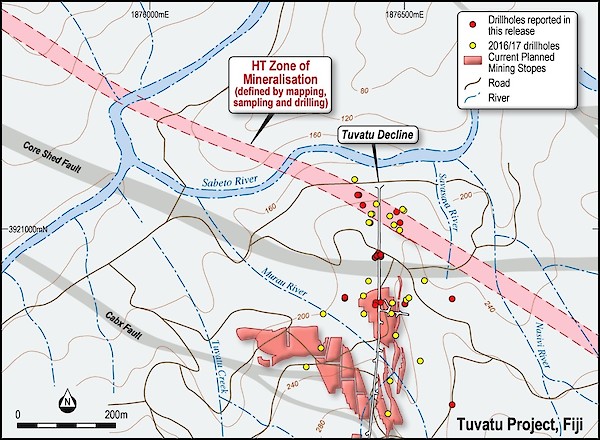
Figure 3: Drill Hole Location and Results from HT Mineralized Zone
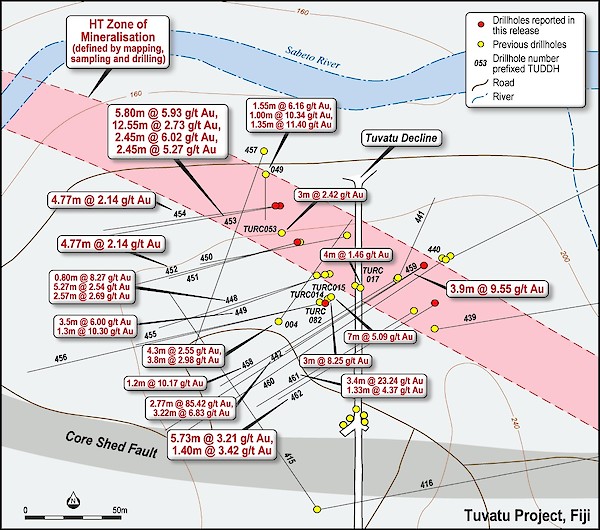
Figure 4: Location of 2017 Underground Diamond Drill Holes
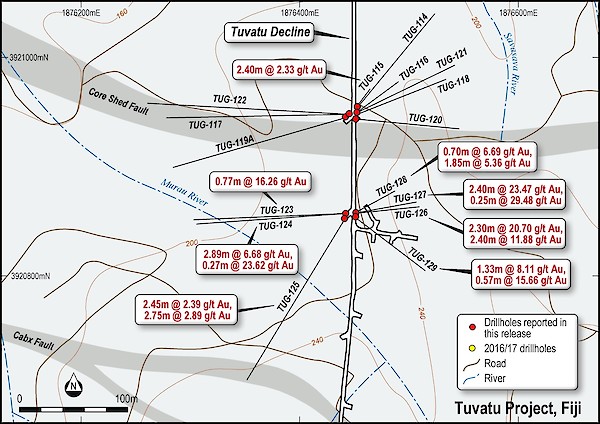
Figure 5: Drill Hole Location Plan of Infill Holes into Existing Resource
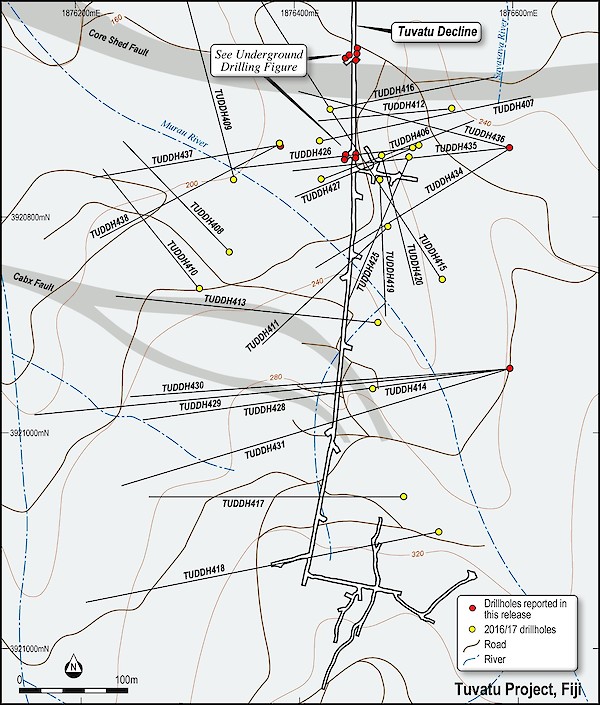
Extensional Exploration at Tuvatu
The Tuvatu Gold Project consists of multiple high-grade structures drilled over a strike-length of approximately 900 meters. Several of the mineralized zones are open along-strike and down-dip and, as noted in this release, there are potential new target areas in the immediate vicinity of the known mineral resource. The first target area for these extensions has highlighted the mineralization identified in Figure 3. The second extensional zone targeted includes the confluence of structures to the south of the existing resource with the holes highlighted in Figure 6. Tuvatu sits within an extensive mineralized district with gold occurrences and geochemistry anomalies extending over an area 6 kilometers by 3 kilometers with several district prospects yet to be adequately tested. The Company is developing an exploration strategy that focuses on new mineralization within the current mineralized envelope, immediate extensional targets and other targets in the district. The aim is to expand the resource base to continue to support long-term sustainable mining operations at Tuvatu.
Figure 6: Drill Hole Location Plan targeting southern extensions at Tuvatu
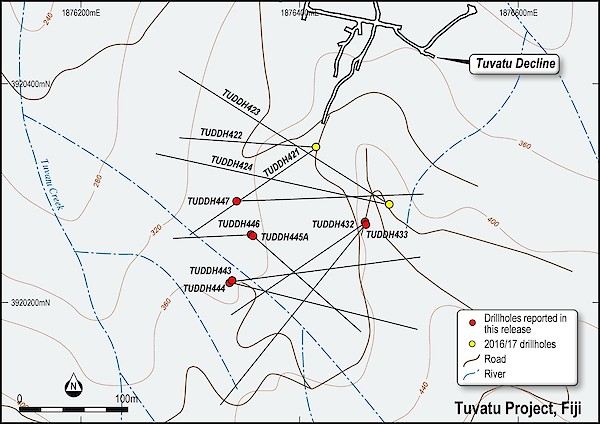
About Tuvatu | Lion One | Fiji Gold
Lion One is aggressively advancing its 100% owned Tuvatu Gold Project as a world class discovery and near-term production opportunity in the southwest Pacific Ring of Fire. Tuvatu is modeled for exploration after regional giants in the low sulphidation family of high grade epithermal gold deposits such as Porgera and Lihir in PNG, and Vatukoula in Fiji. These spectacular discoveries have produced over 35 million ounces of gold in similar alkaline volcanic settings. Tuvatu has been fully permitted by the Government of Fiji for operations startup and has a dual-track strategy of production development and resource expansion inside its 385 hectare mining lease.
Tuvatu is located 17 km from the international airport in Nadi, on the west coast of Viti Levu in the Republic of Fiji. Lion One’s CEO Walter Berukoff is leading an experienced team of mine builders, and has owned or operated over 20 mines in 7 countries. As the founder and former CEO of Miramar Mines, Northern Orion, and La Mancha Resources, Walter is credited with building over $3 billion of value for shareholders.
Tuvatu was advanced by previous owners through underground exploration and development from 1997 through to the completion of a feasibility study in 2000. Acquired by Lion One in 2011, the project has over 110,000 meters of drilling completed to date in addition to 1,430 meters of underground development.
In January 2016 the Hon. Prime Minister of Fiji, Mr. V. Bainimarama, formally presented the previously granted Tuvatu Mining Lease to Lion One. This concluded the permitting process for the development of an underground gold mine and processing plant at Tuvatu, demonstrating strong government support for Fiji’s 85 year-old gold mining industry.
As per its independent June 1, 2015 NI 43-101 PEA Technical Report on the Tuvatu Gold Project, the Company envisages a low cost underground gold mining operation producing 352,931 ounces of gold at head grades of 11.30 g/t Au over an initial 7 year mine life. This includes production of 262,000 ounces at 15.30 g/t through to the end of year three. Estimated cash cost is US$567 per ounce with all-in sustaining cost of US$779 per ounce. Total capex of US$48.6 million includes a contingency of US$6.1 million with an 18 month preproduction schedule and 18 month payback on capital. At a US$1,200 gold price, the project generates net cash flow of US$112.66 million and an IRR of 52% (after tax). The Company is not basing its production decision on a feasibility study of mineral reserves demonstrating economic and technical viability; as a result there is increased uncertainty and economic and technical risks associated with its production decision.
Mine engineering and underground development is progressing alongside final detailed engineering for the Tuvatu processing plant and site infrastructure. The Company has now dewatered the existing Tuvatu exploration decline to 560 meters from the portal down the decline. The decline was completed in the year 2000 by Emperor Gold Mines, comprising 1,430 meters of underground development including drives, cross cuts and raises. In conjunction with the dewatering, ventilation fans and lighting have been installed and are running 24 hours per day. The rehabilitation of the decline is ongoing as dewatering progresses, but in general the stability and ground conditions have been shown to be very good. The areas of rehabilitation and regularly reviewed and approved by Mine Inspectors from Fiji’s Mineral Resource Department.
Stephen Mann, Managing Director of Lion One Metals and member of The Australasian Institute of Mining and Metallurgy, is the Qualified Person (“QP”) responsible for the Tuvatu Mine exploration and delineation programs. Mr. Mann has prepared and approved the scientific and technical disclosure in the news release.
Competent Persons Statement
Information in this announcement relating to exploration drilling at the Tuvatu project is based on data compiled by Lion One’s Managing Director, Mr Stephen Mann, who is a member of The Australasian Institute of Mining and Metallurgy. Mr Mann has sufficient experience which is relevant to the style of mineralization and type of deposit under consideration and to the activity which they are undertaking to qualify as Competent Persons under the 2012 Edition of the Australasian Code for reporting of Exploration Results, Mineral Resources and Ore Reserves. Mr Mann consents to the inclusion of the data in the form and context in which it appears.
The Tuvatu Mineral Resources have been estimated by Mining Associates, an external consultancy, and are previously reported under the 2012 Edition of the Australasian Code for reporting of Exploration Results, Mineral Resources and Ore Reserves (see LOL -ASX announcement 4th June 2014 titled “Lion One Announces Revised NI 43-101 Resource Estimate: Increased Tonnage and Grade at the Tuvatu Gold Project, Fiji”). The Company confirms that it is not aware of any new information or data that materially affects the information included in the original market announcements and, in the case of estimates of Mineral Resources that all material assumptions and technical parameters underpinning the estimate in the relevant market announcement continue to apply and have not materially changed. The company confirms that the form and context in which the Competent Person’s findings are presented have not materially modified from the original market announcements.
The Tuvatu historical exploration results have been sourced from data collected by previously listed companies which have undergone a number of peer reviews by qualified consultants, who conclude that the resources comply with the JORC code and are suitable for public reporting. This information was prepared and first disclosed under the JORC Code 2004. It has not been updated since to comply with the JORC Code 2012 on the basis that the information has not materially changed since it was last reported.
For more information on Lion One including technical reports please visit the Company’s website at www.liononemetals.com or the SEDAR website at www.sedar.com .
On behalf of Lion One Metals Limited
“Walter H. Berukoff”
Chief Executive Officer
For further information please contact
Stephen Mann, Managing Director (Perth, Australia) Tel: 604-973-3007
Hamish Greig, Vice President (North Vancouver, BC) Tel: 604-973-3008
Joe Gray, Investor Relations (North Vancouver, BC) Tel: 604-973-3004
Toll Free IR Line (North America) Tel: 1-855-805-1250
Email: info@liononemetals.com
Neither the TSX Venture Exchange nor its Regulation Service Provider accepts responsibility for the adequacy or accuracy of this release.
This press release may contain “forward-looking information” within the meaning of applicable Canadian securities legislation. All statements, other than statements of historical fact, included herein are forward looking information. Generally, forward-looking information may be identified by the use of forward-looking terminology such as “plans”, “expects” or “does not expect”, “proposed”, “is expected”, “budget”, “scheduled”, “estimates”, “forecasts”, “intends”, “anticipates” or “does not anticipate”, or “believes”, or variations of such words and phrases, or by the use of words or phrases which state that certain actions, events or results may, could, would, or might occur or be achieved. This forward-looking information reflects Lion One Metals Limited’s current beliefs and is based on information currently available to Lion One Metals Limited and on assumptions Lion One Metals Limited believes are reasonable. These assumptions include, but are not limited to, the actual results of exploration projects being equivalent to or better than estimated results in technical reports, assessment reports, and other geological reports or prior exploration results. Forward-looking information is subject to known and unknown risks, uncertainties and other factors that may cause the actual results, level of activity, performance or achievements of Lion One Metals Limited or its subsidiaries to be materially different from those expressed or implied by such forward-looking information. Such risks and other factors may include, but are not limited to: the early stage development of Lion One Metals Limited, general business, economic, competitive, political and social uncertainties; the actual results of current research and development or operational activities; competition; uncertainty as to patent applications and intellectual property rights; product liability and lack of insurance; delay or failure to receive board or regulatory approvals; changes in legislation, including environmental legislation, affecting mining, timing and availability of external financing on acceptable terms; not realizing on the potential benefits of technology; conclusions of economic evaluations; and lack of qualified, skilled labor or loss of key individuals. Although Lion One Metals Limited has attempted to identify important factors that could cause actual results to differ materially from those contained in forward-looking information, there may be other factors that cause results not to be as anticipated, estimated or intended. Accordingly, readers should not place undue reliance on forward-looking information. Lion One Metals Limited does not undertake to update any forward-looking information, except in accordance with applicable securities laws.
